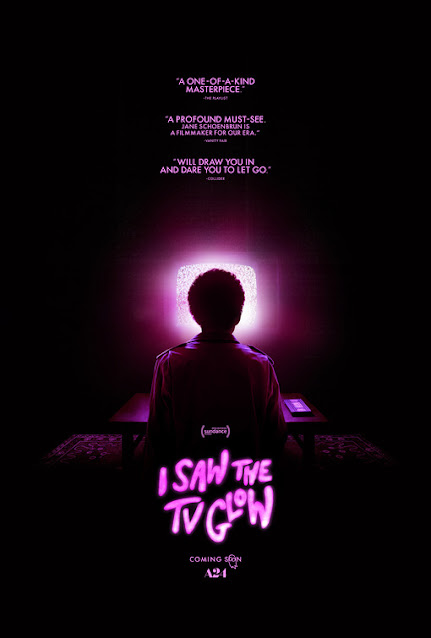American suburbia is a weird bubble. To get here, your family must have some stability. Yet you’re shielded off from so much of the world. Having grown up in Allen, Texas, the suburbs exist in their pocket dimension. You see lots of big houses but not a lot of options for careers, how to dress, or even what life can look like. In all that conformity, it’s no wonder folks turn to escapism. The leads of I Saw The TV Glow are no different. They turn to a Saturday night TV show called The Pink Opaque as a source of joy. This provides relief during gnawing emptiness they can’t really describe or pin down an origin for.
Writer/director Jane Schoenbrun’s latest cinematic depiction of young people getting lost in their screens (following 2022’s We’re All Going ti the World’s Fair) concerns teenager Owen (Justice Smith) and senior Maddy (Brigette Lundy-Paine). They have an odd friendship that’s far from sentimental. However, they share a passion for The Pink Opaque and experiences with dysfunctional households. Eventually, though, this bond comes to a close when Maddy finally makes a good on her promises to leave this one-horse town. Once she vanished, Owen’s obsession with The Pink Opaque continues and Maddy’s influence on him keeps reverberating throughout his life.
I Saw the TV Glow’s most striking visual motif is bright bursts of light existing against darkness. A TV set left on in a dim living room. A bright ice cream truck billowing vivid smoke in the dead of night. An aquarium radiating green hues in a darkened basement. All these fixtures of suburbia often fade into the background in real life. Here, the camera lingers on these objects decked out in vibrant hues. These items provide some color and brightness to the dreary lives of Owen and Maddy. Their personal importance to these two youngsters in beautifully realized through Schoenbrun’s filmmaking. The imagery of I Saw the TV Glow is already enough to make the feature well worth a watch. This is especially true when it comes to the glimpses of The Pink Opaque viewers are privy to.
Schoenbrun perfectly captures the look, feel, and dialogue of a late 90s WB/UPN show combined with the ominous ambiguity of Twin Peaks. You could take these Pink Opaque segments, burn them to a VHS tape, and totally fool people that this was some oddball genre show from years past. Beyond just being authentic, there's a goofy yet oddly charming aesthetic to the pieces we see of this show that make Owen and Maddy's obsession somewhat understandable. You can easily process why somebody would get immersed in this navigating a turbulent life. The cozy familiarity of these digressions into a fictional TV show makes the dreamlike imagery set in I Saw the TV Glow’s “real world” all the more transfixing. “Fiction” has a more consistent visual scheme than reality in this realm.
Part of this concept includes a script that embraces strange a style of dialogue between its primary characters. Owen, Maddy, and everyone else speak in short phrases full of pauses and intentionally didactic wording. It took me a minute to adjust to the rhythm of this verbiage. However, much like Sarah Polley's Take This Waltz or the best Shyamalan films, there's a method to these odd exchanges. These are individuals ground down by capitalism, societal demands, and so many other woes. They're not chatty people, nor are they good at "conventional" social norms. No wonder they find solace in a flickering screen that talks to them yet doesn't expect a response back. Even Maddy and Owen, who've bonded over The Pink Opaque show, don't speak of it in gushing terms to one another. There's a rigidness to their conversations about this pop culture property. It's as if The Pink Opaque is so sacrosanct that to speak of it casually would be blasphemous.
There's so much to unpack just in the way characters talk to one another in I Saw The TV Glow. Get on the wavelength of Shoenbrun's writing and you'll be rewarded mightily. That outcome becomes especially apparent in a lengthy monologue given by Maddy during I Saw The TV Glow that's nothing short of magnificent. It's a tour de force in writing and the very precise line deliveries by Brigette Lundy-Paine. More importantly, though, I Saw The TV Glow functions magnificently in creating visuals channeling the impactful imagery one stumbles onto on TV as a teenager. In that moment, these images unlock something primal in our brains. They could belong to a rerun of an old movie, an obscure TV show, a music video, or anything else. What's important is they help us discover parts of ourselves we couldn't have uncovered anywhere else. They offer a window into corners of our lives that every other aspect of suburbia suppresses. Those flickering images become grandly important, even if they just look like mush to somebody else. I Saw The TV Glow's eerie, neon-colored vision of suburban angst vividly harkens back to those formative memories. Come. Pull up a seat. Let the bright light of the boob tube consume you.

No comments:
Post a Comment